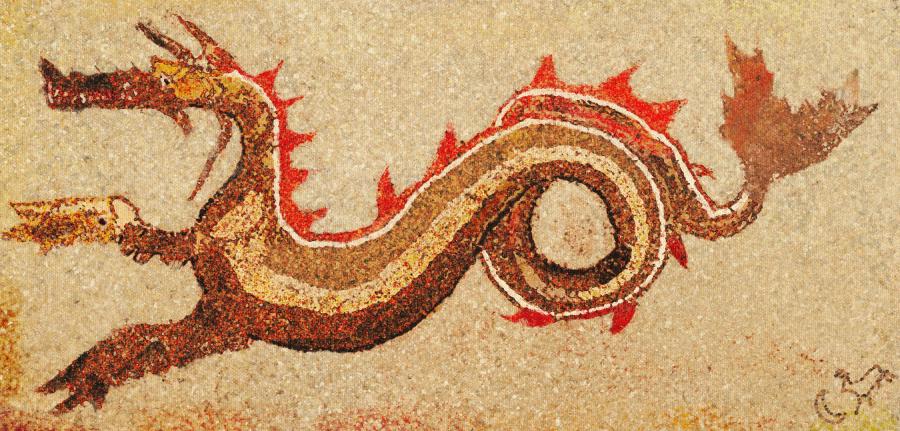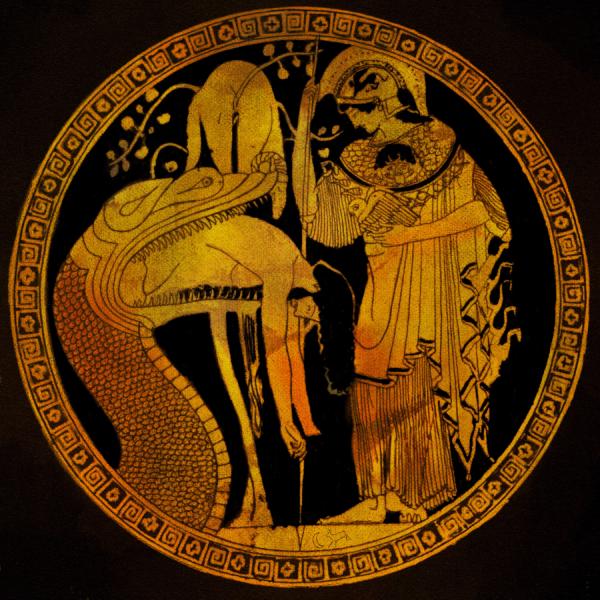The bit about the Greek dragons that I've been stuck on since I decided to drop them in front of those Egyptian dragons I posted (history lesson transitions are some bullshit)…
I originally began the globetrot in Ancient Egypt; however, taking what I've just relayed into consideration, I think Ancient Greece may be the better destination. The reasons are threefold:
⑴ Those for whom the previous passage applies likely received a western education that included at least a little taste of Greek mythology; and, the backbone of Greek mythology is a dragon bone.
⒝ The etymological origin of dragon is the f$&king Greek word drakōn (pronounced δράκων).
(𒄩𒂔𒌈) Some Greek dragons had wings, like the burdened beasts Helios had hauling his chariot about the sky ; but, the majority of these little f$&kers look more like snakes.
Looking like a snake would be totally on-brand for a beastie known to the world as the Lernaean Hydra (which is English for Λερναῖα Ὕδρα) since the word ὕδρα (pronounced hydra) means "water snake" in Greek.

Hera raised this particular hydra for the sole purpose of killing one mighty annoying demigod by the name of Heracles (pronounced Ἡρακλῆς). Buddy's birth-name was actually Alcaeus. Hera sent two serpents to end the boy in his crib. They failed. He'd hoped changing his name to glory of Hera would get her off his ass. It wouldn't. Hesiod's Theogony tells us that the Hydra was the offspring of Typhon and Echidna, two badass MFers, living in the lake of Lerna in the Argolid.
With multiple heads (one of which was immortal … all of which would grow back), poisonous breath, and blood so corrosive it could kill with a whiff, the Hydra was f$&kin' fierce. King Eurystheus gave Heracles the task of slaying this sucker as his second labor (during his post-murdered-my-wife-and-children atonement tour). They battle. Heracles wins. Yada yada yada let's move on I'm bored.
The _kētŏs_or κῆτος (latinized as cetus) I have to show you appears to exhibit a few more physical similarities we might expect from a western dragon (I mean … compared to a snake).

The depicted mosaic was discovered in the floor of an ancient Kaulonian residence now referred to as the House of the Dragon. His attack position pose would suggest that this little fella served as the last line of defense against malevolent forces for the adjacent banquet's airy ambience. The Museo archeologico dell'Antica Kaulon, the mosaic's current home, describes the discovery as, "a polychrome mosaic depicting a sea dragon and … framed by a pattern formed by sea waves."
Let's review. The Lernaean Hydra looked like Hera tied herself a handful of water snakes in an overhand knot like they were auditioning to play opposite of that little, problematically portrayed Japanese Beetle in an episode of The Blue Racer. The Cetus, by comparison, looks all kinds of dragonish. The museum calls him a sea dragon and his place of birth the House of the Dragon. What about a creature whose name f$&king ends with Dragon?
Meet the Colchian Dragon (Δρακων Κολχικος), guardian of the Golden Fleece until Jason and his merry band of Argonauts came calling.

So … yeah … he looks like a f$&king snake. Like I said, if it's a giant serpent, you can probably get away with calling it a dragon. They are all dragons. Just go with it.